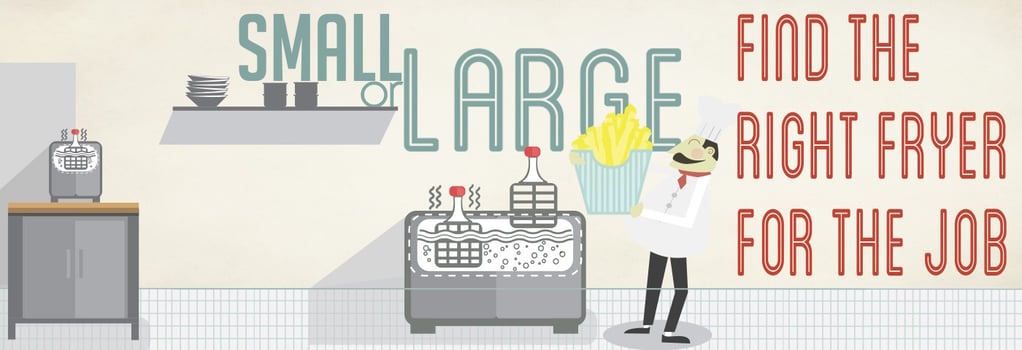What Size Fryer Do You Need?

There are many factors to consider when purchasing a commercial deep fryer, and deciding on the right frypot size may be the most difficult. Sizes range from small countertop single-basket fryers to batteries with as many as five vats. Below are some questions that you can answer to help narrow your commercial fryer choices.
1. What Will You Cook?
The first thing to take into consideration is what you will be cooking. While some food products can share oil with no problem, others, such as fish and chicken, quickly give the oil a distinctive flavor that can contaminate other products if the oil is shared. Typically, meat items should not be fried in the same oil as non-meat items, such as fries or tempura vegetables, and seafood should always have its own vat. With this in mind, consider your menu when deciding how many fry pots you will need. Countertop units usually have one or two fry pots, while a floor model may have as many as five. For restaurants with high-volume frying needs, custom-built fryer batteries offer as many fry pots as needed. These are popular in fast food restaurants and are often automated with programmed timers and basket lifts. To order a fryer battery or for more information about them, please contact KaTom at 1-800-541-8683.
Another thing to keep in mind is what state the food will be in when you cook it. It is generally recommended that operators 'slack' food, or allow it to thaw slightly in a cooler, before frying it. However, some foods are better cooked from frozen, which can have a big impact on the temperatures the oil needs to recover from. If you will be cooking a large quantity of frozen items, going with a size slightly larger than the capacity needed will ensure that it is able to recover quickly when frozen items are added. Also, be sure you aren't overloading the fryer, as this will lessen its ability to recover proper temperatures.
Specialty fryers are available that are designed to cook specific foods. Corn dog fryers have clips to hold the sticks as the corn dogs fry; these are rated by how many corn dogs they can hold and by whether those are regular size or foot-longs. A donut fryer has a large shallow vat with a grate to keep the dough away from the heating elements. Typically called flat bottom fryers, these units can fry as many as 80 dozen donuts per hour and are equipped with a drainboard to ensure pastries don't come out soggy. A funnel cake fryer is also a flat bottom fryer, typically with the heating elements below the vat to keep the cakes from burning. These are listed by how many eight- or nine-inch funnel cakes they can cook at once.
2. How Much Will You Cook?
After you know what you will be cooking, you must estimate how much you will be cooking. This is simple in an established foodservice operation – look at your current numbers and allow for growth. For a new restaurant, however, this can be more complicated. Visit similar restaurants to see how busy they are, and compare that to the capacity your restaurant can handle. Balance this with how much of your menu will be cooked in the commercial deep fryer to come up with an estimate of how much output you will need during your peak hours.
Companies list fryer sizes by the weight of oil a single vat can hold. Most countertop models hold 10 to 30 pounds of oil per pot, while floor models can hold 35 to 100 pounds per pot. The general rule of thumb when looking at fryer capacity is that the unit will be able to put out 11⁄2 to 2 times the weight of the oil in food per hour. This will vary in some situations. For example, frozen food will take longer to cook, so that number will be lower. However, those are good numbers to use as a starting place when looking at commercial fryer sizes.
3. How Much Room Do You Have?
An important thing to keep in mind that can get lost in the shuffle of capacities and projected output is how much space you have for your commercial deep fryer. Floor model fryers vary in width from as small as 15 inches to as large as 78 inches, while battery systems can go far beyond that. You'll need to keep that measurement in mind as you plan the layout of your kitchen. In addition to the size of the fryer itself, consider any special features or add-ons that may benefit you that also take up extra room. For example, dump stations and drain boards can add to the unit's width, but may be worth the space investment depending on what you're making. There are also a few fryer models that incorporate other kitchen elements, such as griddles, in the same unit as the fryer.
In addition to floor space, you must also consider vertical space. Fryers require ventilation, which means you will need room under your kitchen's hood or will need to consider a ventless model. Those units have a built-in exhaust system and will require more vertical clearance than a standard model, but can be placed almost anywhere in the kitchen.
4. Whom Are You Consulting With?
When purchasing a commercial fryer for your kitchen, we would strongly encourage you to speak with a restaurant equipment expert. This is especially important if you are moving up to a larger size or buying the first fryer for a new concept, as these experts can offer insight into how many pounds of fried food you will be likely to sell. To speak with a restaurant equipment specialist, call KaTom at 1-800-541-8683.
